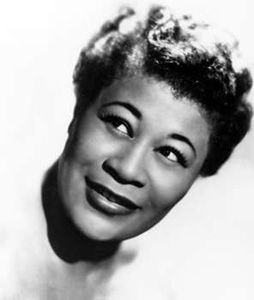| B i o g r a p h y |
 Born: Apr 25, 1917 in Newport News, VA.
Born: Apr 25, 1917 in Newport News, VA.
Died: Jun 15, 1996 in Beverly Hills, CA.
Genres: Jazz
Styles: Vocal Jazz, Traditional Pop, Standards, Swing, Bop, Classic Female Blues.
Instruments: Vocals
"The First Lady of Song," Ella Fitzgerald was arguably the finest
female jazz singer of all time (although some may vote for Sarah
Vaughan or Billie Holiday). Blessed with a beautiful voice and a wide
range, Ella could outswing anyone, was a brilliant scat singer and had
near-perfect elocution; one could always understand the words she sang.
The one fault was that, since she always sounded so happy to be
singing, Ella did not always dig below the surface of the lyrics she
interpreted and she even made a downbeat song such as "Love for Sale"
sound joyous. However, when one evaluates her career on a whole, there
is simply no one else in her class.
One could never guess from her singing that Ella Fitzgerald's early
days were as grim as Billie Holiday's. Growing up in poverty, Ella was
literally homeless for the year before she got her big break. In 1934
she appeared at the Apollo Theater in Harlem, winning an amateur
contest by singing "Judy" in the style of her idol, Connee Boswell.
After a short stint with Tiny Bradshaw, Ella was brought to the
attention of Chick Webb by Benny Carter (who was in the audience at the
Apollo). Webb, who was not impressed by the 17-year-old's appearance,
was reluctantly persuaded to let her sing with his orchestra on a
one-nighter. She went over well and soon the drummer recognized her
commercial potential. Starting in 1935, Ella began recording with
Webb's Orchestra and by 1937 over half of the band's selections
featured her voice. "A-Tisket, A-Tasket" became a huge hit in 1938 and
"Undecided" soon followed. During this era Fitzgerald was essentially a
pop/swing singer who was best on ballads while her medium-tempo
performances were generally juvenile novelties. She already had a
beautiful voice but did not improvise or scat much; that would develop
later.
On June 16, 1939 Chick Webb died. It was decided that Ella would
front the orchestra even though she had little to do with the
repertoire or hiring or firing the musicians. She retained her
popularity and when she broke up the band in 1941 and went solo, it was
not long before her Decca recordings contained more than their share of
hits. She was teamed with the Ink Spots, Louis Jordan and the Delta
Rhythm Boys for some best-sellers and in 1946 began working regularly
for Norman Granz's Jazz at the Philharmonic. Granz became her manager
although it would be nearly a decade before he could get her on his
label. A major change occured in Ella's singing around this period. She
toured with Dizzy Gillespie's big band, adopted bop as part of her
style and started including exciting scat-filled romps in her set. Her
recordings of "Lady Be Good," "How High the Moon" and "Flying Home"
during 1945-47 became popular and her stature as a major jazz singer
rose as a result. For a time (1948-52) she was married to bassist Ray
Brown and used his trio as a backup group. Ella's series of duets with
pianist Ellis Larkins in 1950 (a 1954 encore with Larkins was a
successful follow-up) found her interpreting George Gershwin songs,
predating her upcoming Songbook series.
After appearing in the film Pete Kelly's Blues in 1955, Ella signed
with Norman Granz's Verve label and over the next few years she would
record extensive "Songbooks" of the music of Cole Porter, the
Gershwins, Rodgers and Hart, Duke Ellington, Harold Arlen, Jerome Kern
and Johnny Mercer. Although (with the exception of the Ellington sets)
those were not her most jazz-oriented projects (Ella stuck mostly to
the melody and was generally accompanied by string orchestras), the
prestigious projects did a great deal to uplift her stature. At the
peak of her powers around 1960, Ella's hilarious live version of "Mack
the Knife" (in which she forgot the words and made up her own) from
Ella in Berlin is a classic and virtually all of her Verve recordings
are worth getting.
Ella's Capitol and Reprise recordings of 1967-70 are not on the same
level as she attempted to "update" her singing by including pop songs
such as "Sunny" and "I Heard It Through the Grapevine," sounding quite
silly in the process. But Ella's later years were saved by Norman
Granz's decision to form a new label, Pablo. Starting with a Santa
Monica Civic concert in 1972 that is climaxed by Ella's incredible
version of "C Jam Blues" (in which she trades off with and "battles"
five classic jazzmen), Fitzgerald was showcased in jazz settings
throughout the 1970s with the likes of Count Basie, Oscar Peterson and
Joe Pass among others. Her voice began to fade during this era and by
the 1980s her decline due to age was quite noticeable. Troubles with
her eyes and heart knocked her out of action for periods of time
although her increasingly rare appearances found Ella still retaining
her sense of swing and joyful style. By 1994, Ella was in retirement
and she passed away two years later, but she remains a household name
and scores of her recordings are easily available on CD.